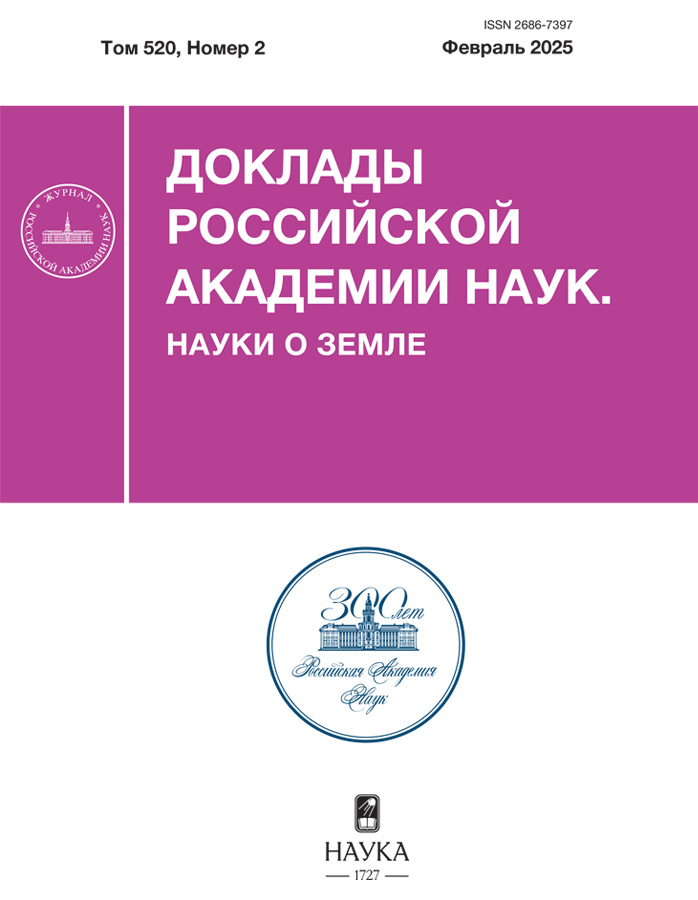Regionalization of forested landscapes in Russia to optimize regional modelling of greenhouse gas flows
- Autores: Kharitonova T.I.1,2, Krinitskiy M.A.1, Rezvov V.Y.1, Maksakov A.I.1, Olchev A.V.1,2, Gulev S.K.1
-
Afiliações:
- Shirshov Institute of Oceanology, Russian Academy of Sciences
- Lomonosov Moscow State University
- Edição: Volume 520, Nº 2 (2025)
- Páginas: 333-339
- Seção: GEOGRAPHY
- ##submission.dateSubmitted##: 19.06.2025
- ##submission.dateAccepted##: 19.06.2025
- ##submission.datePublished##: 04.09.2025
- URL: https://ruspoj.com/2686-7397/article/view/685370
- DOI: https://doi.org/10.31857/S2686739725020186
- EDN: https://elibrary.ru/GCMBLX
- ID: 685370
Citar
Texto integral
Resumo
The regionalization of Russian forest landscapes for spatial extrapolation of greenhouse gas fluxes at regional and national scales was performed. Using the method of simple linear iterative clustering based on 12 variables, the study area was divided into 78 ecoregions. The spatial data on climatic characteristics, surface topography, soil cover and vegetation were collected from open sources and resampled to a grid of 0.0025° × 0.0025°. The results of the clustering were compared with expert-defined geobotanical and physical-geographical regionalization schemes of the territory of the Russian Federation. The identified ecoregions can serve as a basis for establishing new greenhouse gas monitoring sites in forest ecosystems.
Palavras-chave
Texto integral
Sobre autores
T. Kharitonova
Shirshov Institute of Oceanology, Russian Academy of Sciences; Lomonosov Moscow State University
Autor responsável pela correspondência
Email: kharito@geogr.msu.ru
Rússia, Moscow; Moscow
M. Krinitskiy
Shirshov Institute of Oceanology, Russian Academy of Sciences
Email: kharito@geogr.msu.ru
Rússia, Moscow
V. Rezvov
Shirshov Institute of Oceanology, Russian Academy of Sciences
Email: kharito@geogr.msu.ru
Rússia, Moscow
A. Maksakov
Shirshov Institute of Oceanology, Russian Academy of Sciences
Email: kharito@geogr.msu.ru
Rússia, Moscow
A. Olchev
Shirshov Institute of Oceanology, Russian Academy of Sciences; Lomonosov Moscow State University
Email: kharito@geogr.msu.ru
Rússia, Moscow; Moscow
S. Gulev
Shirshov Institute of Oceanology, Russian Academy of Sciences
Email: kharito@geogr.msu.ru
Corresponding Member of the RAS
Rússia, MoscowBibliografia
- Upton S., Reichstein M., Gans F., Peters W., Kraft B., Bastos A. Constraining biospheric carbon dioxide fluxes by combined top-down and bottom-up approaches // Atmos. Chem. Phys. 2024. № 24. P. 2555–2582.
- Xiao J., Chevallier F., Gomez C., Guanter L., Hicke J.A., Huete A.R., Ichii K., Ni W., Pang Y., Rahman A.F., Sun G. Remote sensing of the terrestrial carbon cycle: A review of advances over 50 years // Remote Sensing of Environment. 2019. № 233. P. 111383.
- Pastorello G., Trotta C., Canfora E. et al. The FLUXNET2015 dataset and the ONEFlux processing pipeline for eddy covariance data // Sci Data. 2020. V. 7(225).
- Jung M., Reichstein M., Bondeau A. Towards global empirical upscaling of FLUXNET eddy covariance observations: validation of a model tree ensemble approach using a biosphere model // Biogeosciences. 2009. V. 6(10). P. 2001–2013.
- Hersbach H., Bell B., Berrisford P. et al. The ERA5 global reanalysis // Quarterly Journal of the Royal Meteorological Society. 2020. V. 146(730). P. 1999–2049.
- Fick S.E., Hijmans R.J. WorldClim 2: new 1 km spatial resolution climate surfaces for global land areas // International Journal of Climatology. 2017. V. 37(12). P. 4302–4315.
- Wikle C.K. Spatio-temporal methods in climatology // Encyclopedia of Life Support Systems (EOLSS). 2002.
- Yamazaki D., Ikeshima D., Tawatari R. et al. A high accuracy map of global terrain elevations // Geophysical Research Letters. 2017. V. 44(11). P. 5844–5853.
- Achanta R., Shaji A., Smith K. et al. SLIC superpixels compared to state-of-the-art superpixel methods //IEEE transactions on pattern analysis and machine intelligence. 2012. V. 34(11). P. 2274–2282.
- Golikov V., Krinitskiy M., Borisov D. Visual clustering of ocean sediment grains using a combination of unsupervised machine learning methods / Proceeding of the 6th International Workshop on Deep Learning in Computational Physics (DLCP-2022). Dubna, Russia. 2022. 429 p.
- Огуреева Г.Н., Леонова Н.Б., Булдакова Е.В. и др. Биомы России. Карта в серии карт природы для высшей школы. Масштаб 1:7500000. Издание 2-е, переработанное и дополненное. М.: Всемирный фонд дикой природы (WWF), 2018.
- Карта физико-географического районирования СССР. Гвоздецкий Н.А., Самойлова Г.С. (ред.). Масштаб 1:8000000. М.: ГУГК, 1986.
- Hargrove W.W., Hoffman F.M. Potential of multivariate quantitative methods for delineation and visualization of ecoregions // Environmental management. 2004. V. 34. P. S39–S60.
- Mackey B.G., Berry S.L., Brown T. Reconciling approaches to biogeographical regionalization: a systematic and generic framework examined with a case study of the Australian continent // Journal of Biogeography. 2007. V. 35. No. 2. P. 213–229.
- Ольчев А.В., Гулев С.К. Карбоновые полигоны Российской Федерации: цели, задачи, перспективы // Изменения климата: причины, риски, последствия, проблемы адаптации и регулирования / Под ред. академика РАН И.И. Мохова, члена-корреспондента РАН А.А. Макоско, к.ф.-м.н. А.В. Чернокульского. М.: РАН, 2024. С. 343–355.
Arquivos suplementares











